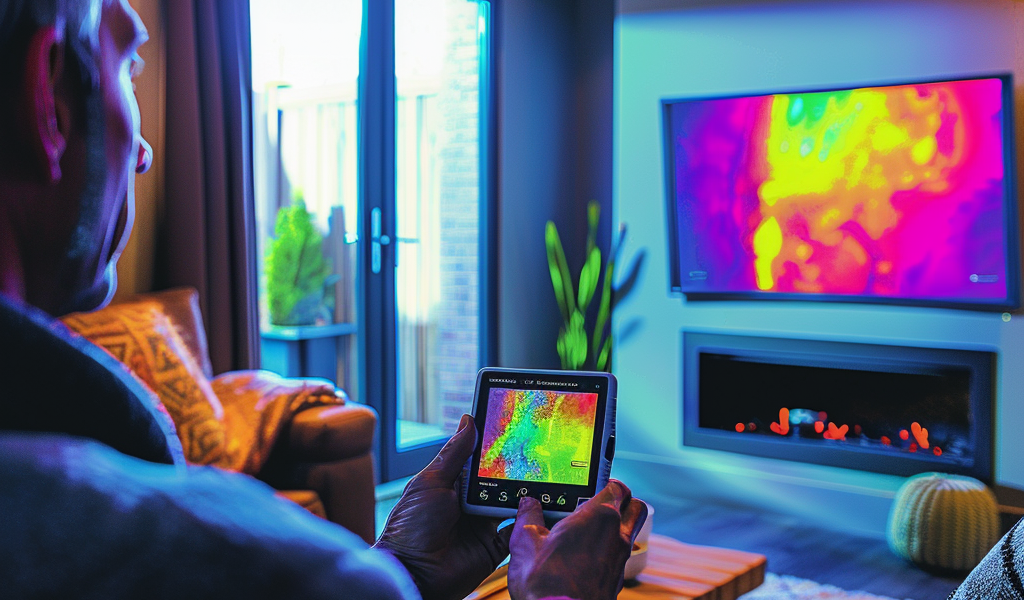In a bid to enhance home energy efficiency and reduce heating costs, homeowners are increasingly turning to thermal imaging cameras to identify areas of heat loss. This innovative technology, likened to having ‘X-ray vision’ for thermal leaks, has gained traction among those looking to improve their living conditions while minimizing carbon footprints.
One such homeowner, Jamie Matthews, a web engineer based in the southeast of England, purchased a thermal imaging camera last year. His experience with the device unveiled several surprising insights into his home’s insulation efficiency. Upon using the camera, Matthews discovered that his loft hatch was a significant source of heat loss, revealing cool areas that indicated where warmth was escaping.
“That was really obvious on the camera,” Matthews noted, emphasizing the clarity with which the device highlighted insulation weaknesses. Beyond the loft hatch, he also identified small gaps in external walls and less insulated sections of his roof. “It’s good fun and it certainly shows up things that may not be immediately obvious,” he added.
While Matthews managed to address some of the draughts himself, he acknowledged the importance of a more comprehensive approach for larger renovations. Following his initial findings, he opted for a professional heat loss survey when he decided to install a heat pump, underscoring the value of expert guidance in energy efficiency projects.
Building physics researchers have noted a rising trend in the use of thermal cameras among homeowners, particularly as they seek to cut down on heating expenses and reduce their environmental impact. Many local councils are responding to this demand by offering residents the opportunity to borrow thermal cameras for free, enabling them to assess heat loss in their own homes.
For instance, Wiltshire Council recently introduced a program allowing residents to borrow 11 thermal imaging devices from local libraries. According to Councillor Ian Blair-Pilling, the initiative has seen a “huge uptake,” resulting in a waiting list for interested community members. “Expert advice, combined with a measured approach to the findings from thermal imaging, will give residents the best chance of making informed decisions about energy-saving home improvements,” he stated.
Jo Atkinson, a senior consultant in buildings decarbonisation at the Energy Systems Catapult, cautions homeowners to interpret thermal images with care. While the technology can provide valuable insights, she emphasizes the need for professional advice, especially when planning significant home improvements.
Thermal cameras operate by detecting infrared radiation, which is emitted by objects based on their temperature. Although these devices can be pricey, with Matthews spending around £160 for his, various organizations, including local councils and energy suppliers like Octopus Energy, offer them for loan at no cost. This accessibility makes it easier for homeowners to gain a preliminary understanding of their home’s thermal performance.
The growing interest in thermal imaging is largely driven by the urgent need to address energy efficiency in the face of rising energy costs and climate change. By identifying and rectifying heat loss, homeowners can not only save money but also contribute to broader sustainability efforts.
In addition to the immediate benefits of reduced heating bills, addressing heat loss can also improve overall comfort levels within the home. Cold drafts and poorly insulated areas can lead to a host of health issues, particularly during the colder months. Therefore, small interventions identified through thermal imaging can play a critical role in maintaining a warm and healthy living environment.
As more individuals become aware of the advantages of thermal imaging, the technology is likely to become a standard tool in home energy assessments. With the support of local councils and energy organizations, homeowners are empowered to take proactive steps toward enhancing their home’s energy efficiency.
In conclusion, the rise of thermal imaging cameras represents a significant shift in how homeowners approach energy efficiency. By leveraging this technology, individuals can identify hidden heat loss, make informed decisions about home improvements, and ultimately contribute to a more sustainable future.





